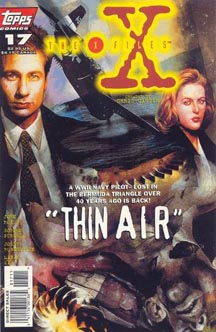The first dozen issues of the Topps “X-Files” Comics featured Stefan Petrucha’s conspirators-within-the-conspiracy, the Aquarius group. But at the same time, the TV show’s mythology was becoming more complicated. Perhaps in response, the Topps writers – Petrucha in Issues 13-16, John Rozum in 17-19 and 22-24 and Kevin J. Anderson in 20-21 — decided to tone down the comics’ mythology and focus on stand-alone stories in 1996 (which corresponded with the end of Season 3 and the start of Season 4 on TV).
The last mention related to the Aquarius mythology comes early in this batch when Mulder references the Neola, Kan., UFO crash (as explored back in Issue 2). Still, in his final four issues, Petrucha does feature UFOs (a.k.a. “fallen angels,” a term from the Season 1 episode “Fallen Angel”) in three of them. He doesn’t directly tie his stories into the mythology, but he does close out “Home of the Brave” (15-16) with a military man telling Mulder and Scully “This was a need-to-know operation, agents, and you don’t need to know this.” His soldiers secure the scene of the sighting of the UFO, which Scully thinks could be “an experimental jet.”
Petrucha’s final three issues are thematically heavy-handed. “Falling” (14) is a “Lord of the Flies” riff wherein a kid – who reminds me of the boy born without a soul in the “Angel” Season 1 episode “I’ve Got You Under My Skin” – kills his friends and nearly kills a burn-scarred Mulder, who he believes is an alien. The final panel showing soldiers suggests that this boy learned his behavior from adult examples. “Home of the Brave” then follows up with horribly clichéd survivalists who come across a UFO.
But “One Player Only” (13) shows how a clichéd topic – in this case, the idea that people who play (or program) video games can become detached from reality and commit real violence – can be given a fresh spin. Rather than a computer gaining human-style sentience (as explored in Season 1’s “Ghost in the Machine” and Season 7’s “First Person Shooter,” and most famously in “2001: A Space Odyssey”), here a man’s brain is taken over by the computer.
When Petrucha moved on to other projects, Rozum took over and the quality of the writing remained fairly high. Likewise, the art by Gordon Purcell is an even match for that of Charles Adlard (who isn’t quite done with “The X-Files,” although Purcell handles Rozum’s lead-off issue). Purcell’s likenesses are more picture-perfect, but the crispness sacrifices the mood slightly.
“Thin Air” (17) is a meaty debut from Rozum, about a World War II pilot who disappeared into the Bermuda Triangle and reappears unaged a half-century later (the “reappearing unaged” idea was later explored in Season 8’s “Invocation”). In a rare nod to the mythology from Rozum, the Cigarette-Smoking Man appears on the final panel in an unknown location with all of the missing pilots. As with a lot of “X-Files” yarns – especially as the series went forward — we don’t get a clear solution to this mystery, but Mulder’s theory is a good one: He thinks the conspirators released the pilot to the public along with a purposely shoddy cover-up. That way, any future people who claim to have reappeared from the past won’t be believed. (The idea that the alien mythology is a smokescreen to distract Mulder would later be famously explored in the “Gethsemane” trilogy that bridged Seasons 4 and 5. Of course, that “smokescreen” turned out to be a smokescreen – there really was an alien-government conspiracy.)

The two-parter “Night Lights” (18-19), on the other hand, is a clunker. Mulder, Scully and a scientist theorize endlessly about ball lightning even as we the readers have already figured out that, yes, a sentient ball of lighting did indeed murder a group of scientists.
Rozum more effectively plays out the mystery in his last three issues of ’96. “The Kanashibari” (22), a rare case that brings the agents to Hawaii, touches upon the myth of an incubus- or succubus-style ghost that literally scares people to death. The grisly “Donor” (23) finds an organ donor coming back from the dead to take back his organs. This is one of those “X-Files” that veers completely off the track of making any kind of sense, but it’s still entertaining. And “Silver Lining” (24) is a “Picture of Dorian Gray” riff, with the mirror in the lining of a trenchcoat for some reason.
Considering how good his first two “X-Files” novels (“Ground Zero” and “Ruins”) were, I had high hopes for Anderson’s “Family Portrait” (20-21), but like “Night Lights,” the answer to the mystery is obvious from the beginning: A weird camera doesn’t just capture people’s images, but also a piece of their essence, thus aging (and ultimately killing) them. Both “Family Portrait” and “Silver Lining” call to mind Season 2’s “Dod Kalm,” wherein Mulder and Scully prematurely age, although only in “Silver Lining” do the agents make reference to that previous case.
It’s inevitable that as a franchise grows, there will be more repeats of story ideas. But through two years of the comic title, there’s no sense of burnout, despite a few issues that misfire. Rozum isn’t as much of a meticulous researcher as Petrucha, but he enthusiastically explores sci-fi and paranormal concepts. While he resists connections to the wider mythology, he’s still willing to put the agents through their paces with yarns that could be storyboards for monster-of-the-week TV episodes that never came to be.

